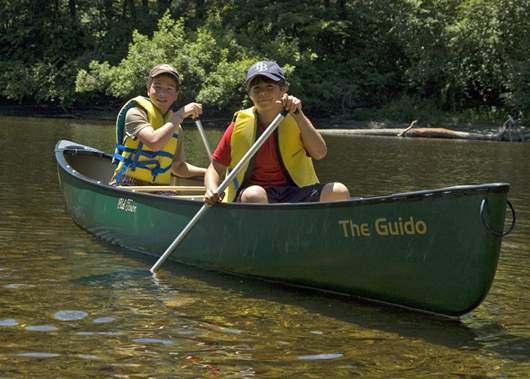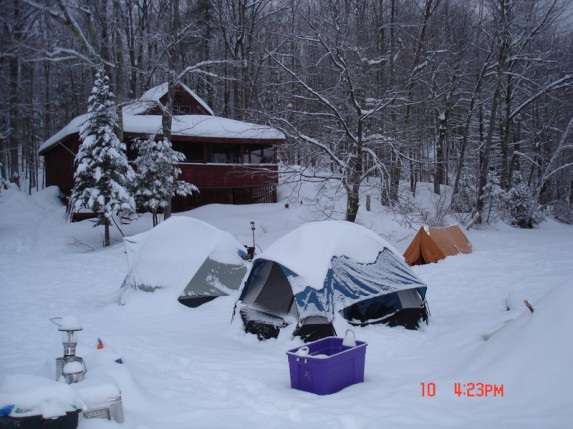Weekend Trips
Troop 127 plans a camping trip generally every month from September through June. Some are annual favorites, others are new and untried. We’ve camped as near as Concord and Sudbury and as far away as Maine and Nantucket. Trips usually leave Saturday morning and return Sunday early evening, but occasionally we stay over two nights. We plan a longer trip for Columbus Day weekend, and make an annual pilgrimage to Marshall Pond for winter camping on the ice. Parents are encouraged to come on camping trips with the troop. We need drivers, chaperones and adults to ensure 2-deep leadership at all times, and it’s fun!
Equipment
There is a lot of equipment you need to go camping, but that does not mean that you have to go out and immediately buy a lot of expensive gear. When looking for camping equipment keep in mind that scouts start off small and grow rapidly (a sleeping bag that fits today will be too small tomorrow). Many items can be borrowed from the troop or other scouts. More information about equipment is available on our Resources page.
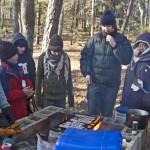 Troop 127 has gas stoves, large water containers and some coolers that can be used by the patrols. Patrols generally supply and cook their own food. The patrol plans meals during regular troop meetings and appoints one scout to purchase the food and pack it into a cooler.
Troop 127 has gas stoves, large water containers and some coolers that can be used by the patrols. Patrols generally supply and cook their own food. The patrol plans meals during regular troop meetings and appoints one scout to purchase the food and pack it into a cooler.
A 25° (F) sleeping bag is more than adequate for most of the trips. Even when the temperature goes down to zero the Scouts will be sleeping inside tents with other Scouts, dressed, and with a bag liner or blanket inside the bag. Sleeping bags filled with down are to be avoided. Although they are the “warmest and lightest” they lose almost all of their insulating ability when they get wet (a common occurrence) and cannot be dried out on a camping trip. The new synthetics are almost as good as down, retain most of their insulating capability when wet, and can be dried on a camping trip. Mummy bags are good because they heat up faster, are lighter and easier, and usually come with a hood to keep the head warm. They can sometimes be uncomfortable for new Scouts, however, because they feel constrictive. If you would like to try out gear before purchasing, visit REI in Reading – they rent out equipment.
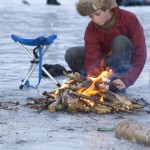 Boots are an essential for camping. Sneakers do not provide any ankle support and quickly get wet with a little rain. Boots should go above the ankle and should have a gusseted tongue (the tongue has extra material to the sides that attach to the boot) so that water and dirt are kept out. Look for a minimum number of sewn seams (because they all have to be waterproofed) and a cemented or sewn sole. Get a good foot liner to help wick moisture out of the boot. See pages 200-201 of the Scout Handbook for more information about boots and socks.
Boots are an essential for camping. Sneakers do not provide any ankle support and quickly get wet with a little rain. Boots should go above the ankle and should have a gusseted tongue (the tongue has extra material to the sides that attach to the boot) so that water and dirt are kept out. Look for a minimum number of sewn seams (because they all have to be waterproofed) and a cemented or sewn sole. Get a good foot liner to help wick moisture out of the boot. See pages 200-201 of the Scout Handbook for more information about boots and socks.
Always pack extra socks. Socks should be made of polyester or wool. Once cotton socks become wet (sweating), they stay wet, but polyester and wool socks wick the moisture away from the skin. Even in mild camping weather, feet can become extremely cold with cotton socks! Scouts should have a fresh pair of socks to change into at night, and another pair for the morning.
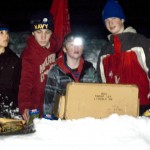 Many scouts use headlamps, which allow you to use the lamp and still have both your hands free. The headlamp is particularly convenient when Scouts are finishing cleaning up after dinner at dusk.
Many scouts use headlamps, which allow you to use the lamp and still have both your hands free. The headlamp is particularly convenient when Scouts are finishing cleaning up after dinner at dusk.
Don’t go out and buy those army style mess kits where everything fits inside everything else. They are made of metal which lets the food get cold quickly and easily get bent out of shape. What you want is a good study plastic plate and bowl that will not break when dropped or stuffed into a pack on the way home. Utensils can be any old mismatched set of knife, fork, and spoon that you won’t worry about if it doesn’t come home. For drinks use a good plastic mug. Don’t get a collapsible cup. Many of our Scouts have plates and bowls made of Lexan polycarbonate.
Almost everyone goes through what we call an “evolution” in raingear. First year Scouts usually wear a poncho. It’s easy to pack, quick to put on, and works for about five minutes in a downpour, unless you’re hiking. By the second year they’ve switched to a plastic or rubber coated rainsuit. While this offers more protection Scouts eventually realize that they are sweating inside as much as its raining outside. Finally they end up in a nylon or Gore-tex rainsuit that lets the body breath and also serves as a jacket when it is cooler. By this time, the Scout has grown significantly, and hopefully will be able to use this rainsuit well into young adulthood.
A water bottle is essential for camping. Most of our scouts carry Nalgene bottles or something similar and clip them to their belt loops with carabiners. Some scouts use Camelback style backpacks, great for hiking but not as good for carrying cooking water.
Packing
Never let someone else pack for you, not even your parents!!! You are the one going camping and in the middle of the night when your flashlight dies and you need your spare batteries, you are the one who needs to know in what pocket of the backpack they are. One of the other older scouts should be inspecting your pack for the first campout or two to show you how and to make sure that you haven’t forgotten anything.
